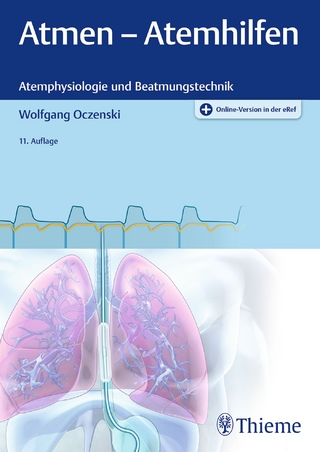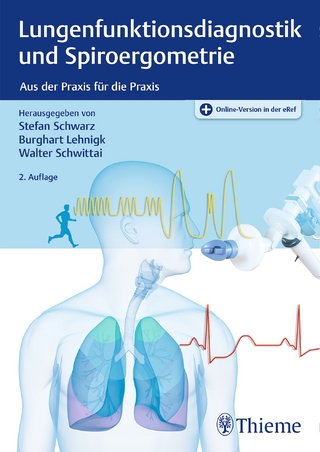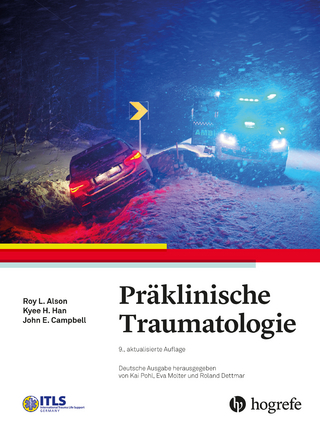
Respiratory Muscle Strength Training
Plural Publishing Inc (Verlag)
978-1-63550-257-2 (ISBN)
Respiratory Muscle Strength Training is a clinical guide, intended to provide clinicians with the background information they need to understand respiratory muscle strength training (RMST). With a variety of case studies provided by well-known authors and clinicians, this text acts as a guidebook to the RMST protocol and provides practical information for use in the field of healthcare.
In addition to real-world case studies, Respiratory Muscle Strength Training includes a chapter devoted to Frequently Asked Questions, a representative sample of the devices commonly used for respiratory training, and instructions for using them in patient care.
Christine Sapienza, PhD, CCC-SLP, serves as the Dean of the Jacksonville University, Brooks Rehabilitation College of Healthcare Sciences. Previously, Dr. Sapienza was a longstanding tenured professor and chair of the Department of Communication Sciences and Disorders at the University of Florida, as well as a research career scientist at the Brain Rehabilitation Research Center at the Malcom Randall Veterans Administration Hospital. As a principal investigator of National Institutes of Health grants, VA Research Rehabilitation Research and Development Awards, and a M.J. Fox Foundation grant, Dr. Sapienza has provided extensive mentoring to 16 doctoral students, all of whom have contributed back to academics and clinical service. She has built a strong national and international reputation for expertise in the design and implementation of larger scale randomized clinical trials examining treatments as well as the careful reporting of peer-reviewed outcomes from these studies. Dr. Sapienza methodically disseminates this information to the scientific community at large in the form of invited presentations, workshops, and clinical teaching platforms. Through writing, she works to integrate research findings in journal articles, textbooks, and clinical manuals. As a frequent contributor to patient support groups she aspires to assist patients and caregivers as they navigate available treatments and emerging science. Most recently, Dr. Sapienza was selected as Jacksonville's Women of Influence.++++++++++++++++++++++++++++++++++++++++++++++++++++++++++Bari Hoffman, PhD, CCC-SLP, is an Associate Professor in the Department of Communication Sciences and Disorders and jointly appointed as Associate Professor, Internal Medicine at the University of Central Florida. Dr. Hoffman serves as research partner to the Florida Hospital Cancer Institute and Director of the Center for Voice Care and Swallowing Disorders at the Ear Nose Throat and Plastic Surgery Associates. She has worked clinically in this setting for more than 18 years treating individuals with voice and upper airway disorders specializing in pediatric, professional and neurogenic populations, along with individuals undergoing treatment for head and neck cancer. Dr. Hoffman Ruddy received her doctoral degree from the University of Florida in 2001. Her current research involves studying novel treatment technologies and biomechanical mechanisms for disorders of laryngeal function while defining the high impact on quality of life factors. She implements 3-D computer modeling of upper and lower airway function, coping strategies of individuals with dysphonia and respiratory muscle strength paradigms in a variety of patient groups. Dr. Hoffman has a significant record of peer-reviewed publications, authorship of multiple textbooks, and actively lectures across the country on these topics. In recognition of her contributions to teaching, research, and service, she has received numerous awards within her University and state association.
Preface
About the Editors
Contributors
Chapter 1. Respiratory Anatomy and Physiology
Christine Sapienza
Chapter 2. Neuroanatomy and Neurophysiology of the Respiratory System
Christine Sapienza
Chapter 3. The Laryngeal Valve
Gayle Woodson
Chapter 4. Skeletal Muscle Structure and Function
David Hooper, Catherine Saenz and Carena Winters
Chapter 5. Respiratory Muscle Training
Scott K. Powers, Mustafa Ozdemir, Matthew P. Bomkamp, and Hayden Hyatt
Chapter 6. Respiratory Muscle Strength Training Devices
Christine Sapienza
Chapter 7. Respiratory Training for Special Populations
Christine Sapienza, PhD and Michelle Troche
Chapter 8. Inspiratory Muscle Strength Training in an Adolescent with Grade 1 Subglottic Stenosis
Susan Brehm and Barbara D. Weinrich
Chapter 9. Exercise Induced Laryngeal Obstruction and Inspiratory Muscle Training
Astrid Sandnes, Hege Havstad Clemm, Tiina Andersen, Thomas Halvorsen, and Ola Drange Røksund
Chapter 10: Using Expiratory Muscle Strength Training with Velopharyngeal Insufficiency (VPI) Conditions
Yaser S. Natour and Wesam B. Darawsheh
Chapter 11: Incorporating RMST into Voice Therapy for a Patient with Vocal Fold Paresis
Adam T. Lloyd, Michelle M. Bretl, and Jennylee Diaz
Chapter 12. Using EMST for Treatment of Dysphagia for a Complex Patient in the Acute Care Setting
Vicki Lewis
Chapter 13. The Use of Expiratory Muscle Strength Training in the Treatment of Chronic Refractory Cough and Presbyphonia
Austin Collum and Emily Dunn
Chapter 14. Respiratory Muscle Strength Training for Treatment of Communication and Swallowing Deficits in Tracheostomy and Ventilator Dependent Patients
Maribel Ciampitti
Chapter 15. Respiratory Muscle Strength Training for a Patient with Head and Neck Cancer
Irene de Pedro Netto Vartanian, Jose Guilherme Vartanian, and Renan Bezerra Lira
Chapter 16. RMST Case: Late Radiation-Associated Dysphagia (Late-RAD) in Head and Neck Cancer Survivorship
Carly E. A. Barbon and Katherine A. Hutcheson
Chapter 17. Expiratory Muscle Strength Training (EMST) in the Laryngectomized Patient
Bari Hoffman Ruddy, Vicki Lewis, and Henry Ho
Chapter 18. Frequently Asked Questions
Christine Sapienza
Appendix A. Representative Sample of Devices Used for Respiratory Training
Appendix B. Instructions for Using Respiratory Training Devices
Index
| Erscheinungsdatum | 27.05.2021 |
|---|---|
| Verlagsort | San Diego |
| Sprache | englisch |
| Maße | 152 x 229 mm |
| Themenwelt | Medizin / Pharmazie ► Gesundheitsfachberufe ► Logopädie |
| Medizinische Fachgebiete ► Innere Medizin ► Pneumologie | |
| ISBN-10 | 1-63550-257-8 / 1635502578 |
| ISBN-13 | 978-1-63550-257-2 / 9781635502572 |
| Zustand | Neuware |
| Haben Sie eine Frage zum Produkt? |
aus dem Bereich


